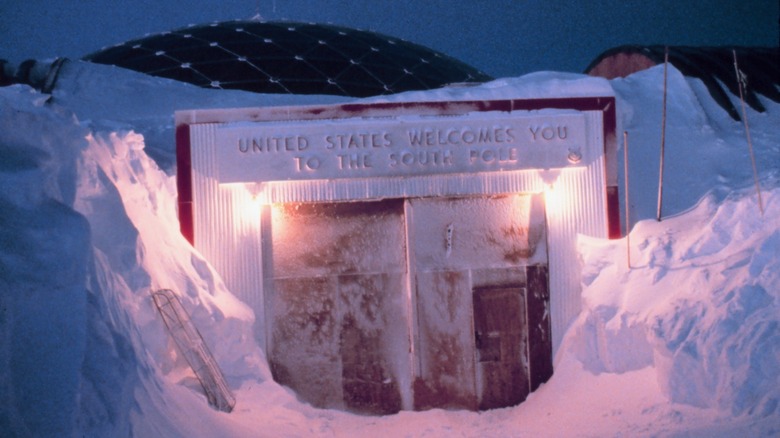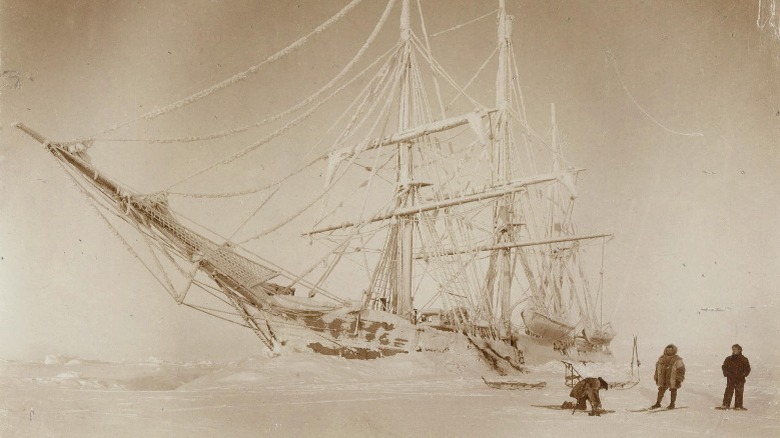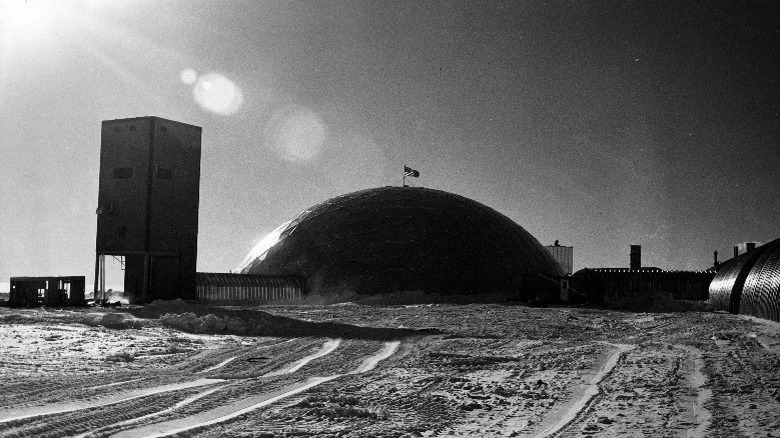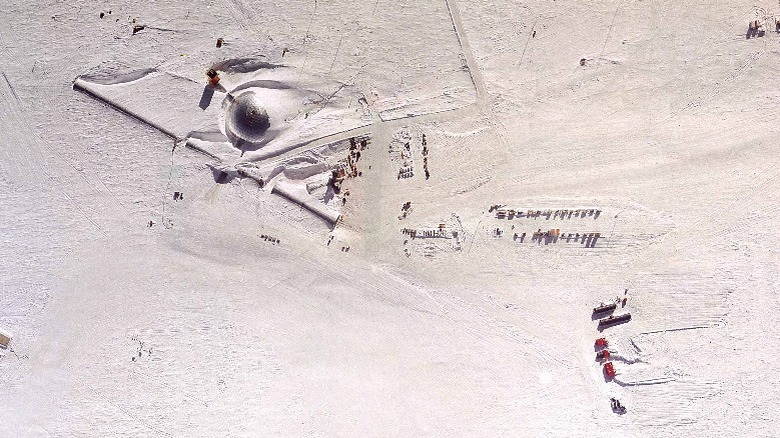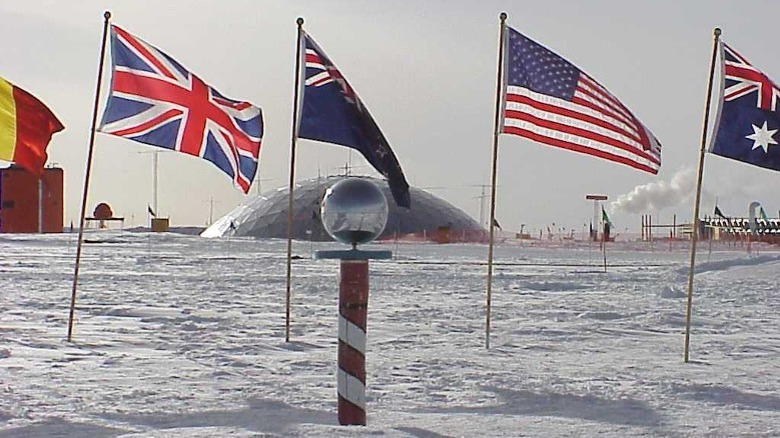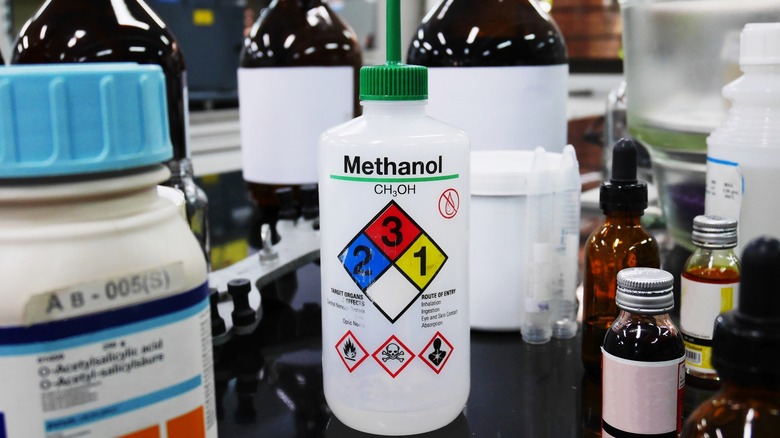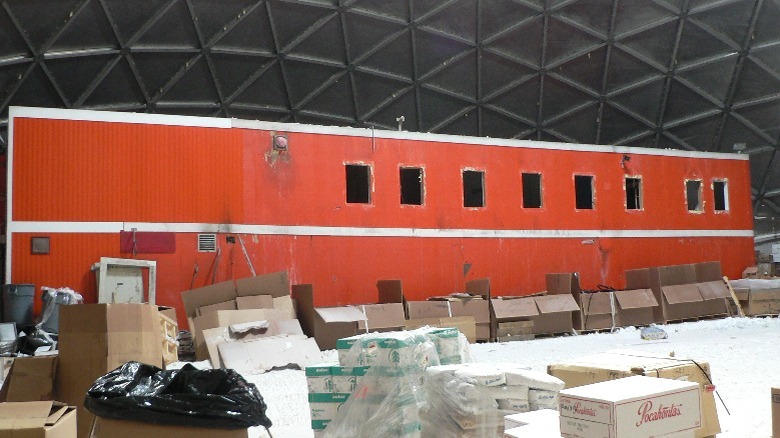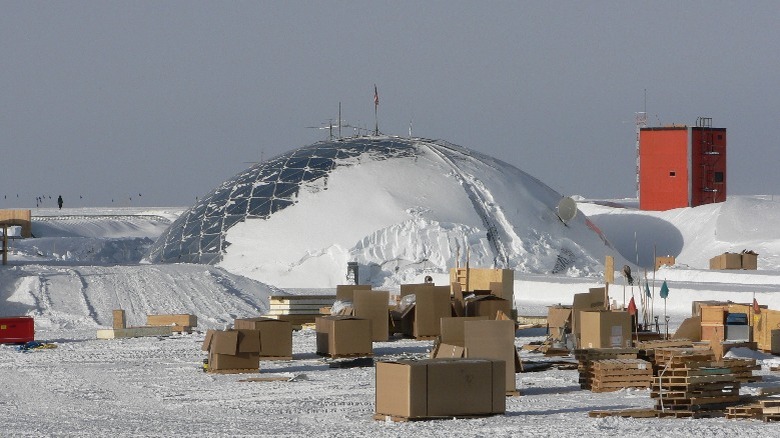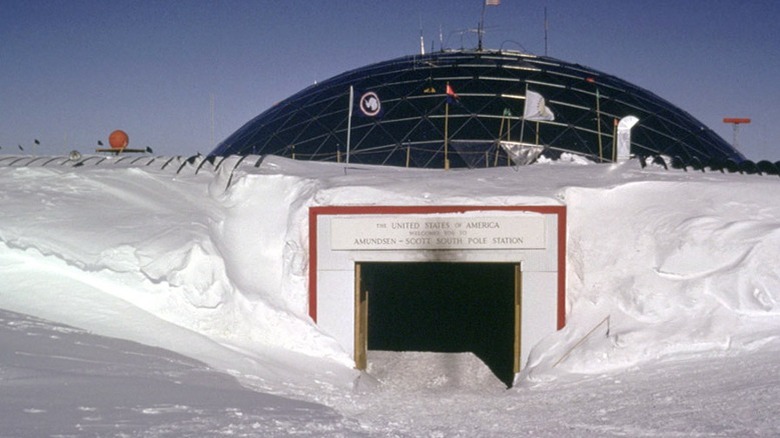The Mysterious Death Of Rodney Marks In Antarctica
The more adventurous people out there might dream of visiting Antarctica for a couple of days, but few would want to spend an extended amount of time there. And that's just when it's summer and "warm" with up to 24 hours of sunlight a day. Why anyone would willingly spend months at the bottom of the Earth in the winter is something else entirely. Unbelievable cold, constant darkness ... how could anyone handle it?
Now imagine you are in that situation and one of the few people living with you suddenly and mysteriously dies. That was the reality for those working at the Scott-Amundsen research station in Antarctica on May 12, 2000, when Rodney David Marks died. According to his obituary, posted by the National Science Foundation, Marks was an Australian citizen. He had returned to Antarctica for a second winter to work for the Smithsonian Astrophysical Observatory, as part of the Antarctic Submillimeter Telescope and Remote Observatory (AST/RO) project.
The 32-year-old astrophysicist had been sick for approximately a day and a half prior to his death. Months later it was confirmed that Marks died of methanol poisoning. However, it was never positively confirmed why the poison was in Marks' system or exactly how it was administered. Here is the story behind the mysterious death of Rodney Marks in Antarctica.
Antarctica has been called the Madhouse at the End of the Earth
The first known scientific exploration of Antarctica began on August 16, 1897. The Belgian Antarctic Expedition traveled through the frigid waters aboard the Belgica, without any significant concerns, for seven months. However, as winter descended on the region, the Bellingshausen Sea began to freeze and the ship was ultimately trapped (pictured). Via GQ, author Julian Sanction, who wrote the book, "Madhouse at the End of the Earth," explained that the crew and passengers of the Belgica were woefully unprepared for the extreme conditions they encountered on the harrowing expedition. In his logs, Belgica Captain Georges Lecointe included accounts of at least two people who descended into severe mental illness and paranoia.
In Antarctica, the summer season lasts from October to February, and the sun does not set for more than two months. During the winter season, which lasts from March to September, the sun does not rise for several months, and the temperatures can plunge to astonishingly low temperatures in the central regions, the record being -129.3 degrees Fahrenheit. GQ reports English explorer Frank Wild, who traversed Antarctica in the early 1900s, said, "In all of my six expeditions quarrels & squabbles have taken place, & men's tempers most naturally become frayed when herded together in close quarters under the trying conditions of a polar winter."
Through the early to mid-1900s, multiple accounts of aggression, mental breakdowns, and paranoia among antarctic explorers led to persistent rumors that the extreme conditions drove people to madness.
The Amundsen-Scott Station
The Amundsen-Scott Station, which was named in honor of early 20th-century explorers Roald Amundsen and Robert F. Scott, is located at the geographic South Pole at an elevation of approximately 9,306 feet on a 9,000-foot-thick ice sheet. The average temperature at the station ranges from 8 degrees Fahrenheit to -115 degrees Fahrenheit, and the average snowfall is approximately eight inches.
Scientists have been at the South Pole full-time since the mid-1950s. The first Antarctic station was completed in February 1957 and was sufficient for the number of researchers who lived and worked in the region. However, due to increased interest in polar research, the National Science Foundation reports the original station was rebuilt and expanded in 1975. Through the years, the station has been renovated and expanded multiple times, and currently includes several modular buildings and a number of detached buildings. The station also has numerous elevated structures, which are more stable than previous builds, and includes a medical facility. However, much of this was added in the decade after Rodney Marks was there.
According to the National Science Foundation, the Amundsen-Scott Station can support multiple branches of scientific research, including astronomy, astrophysics, biology, climate systems, geophysics, and glaciology. The Amundsen-Scott Station is busiest in the summer season, with more than 150 scientists and support personnel present. When the sun dips below the horizon, only around 50 are left to winter over.
The harsh reality of working in isolation and extreme conditions
Although the stations in Antarctica, including the Amundsen-Scott Station, have been expanded and modernized to facilitate efficient and thorough research, as well as more abundant and comfortable housing, scientists and personnel at the stations continue to experience difficulty adjusting to the extreme conditions. As reported by Canadian Geographic, venturing outside, during the winter months in particular, is less than ideal, and the living quarters can begin to feel oppressive. The altitude can also contribute to the oppressive feeling, as atmospheric oxygen is lower than in other parts of the world.
People working at the Antarctic station also experience boredom, homesickness, feelings of isolation, and the stress of being confined with colleagues they may not get along with. To counter these issues, camaraderie and teamwork are heavily encouraged in an effort to provide a strong support system for everyone at the station.
At the Amundsen-Scott Station, the coldest days begin during the month of March. As the weather makes it dangerous, or simply impossible, no flights are allowed to or from the station during the winter season. In an effort to prevent unexpected issues, scientists and personnel are required to undergo extensive medical testing to ensure they are in good health. Men's Journal reports some of the medical requirements are rumored to include perfect dental health and the absence of preexisting conditions that could require surgery. Candidates must also undergo a series of psychological tests and interviews.
Rodney Marks was ill for three days prior to his death
Rodney Marks underwent the same medical and psychological testing as the rest of his colleagues. He also fully understood the implications of living in the extreme conditions at the Scott-Amundsen research station, as he spent the winter of 1997-98 at the same station. Shortly after arriving at the Scott-Amundsen Station in November 1999, Men's Journal reports Marks met and fell in love with fellow researcher Sonja Wolter. Within months, the two were engaged. Marks' daily routine included a half-mile walk from the main station to the observatory where he worked, and back. In his free time, he taught an astronomy class, played poker, and hung out with his colleagues.
On the evening of May 11, 2000, Marks was returning to the main station when he began feeling ill. He mentioned to his colleagues that his eyes were hurting and he had burning pain in his stomach. At 5:30 the following morning, Marks woke up with severe stomach pain and was vomiting blood. Although he visited the station's physician, Dr. Robert Thompson, twice, the doctor was unable to make a definitive diagnosis based on Marks' symptoms. According to Men's Journal, he eventually gave Marks a sedative and suggested he may be experiencing severe anxiety or alcohol withdrawal.
As his symptoms continued to worsen, Marks went to the doctor a third, and final, time. Thompson gave Marks an antipsychotic, which sedated him almost immediately. However, he lost consciousness and ultimately died.
Rodney Marks' manner of death was initially presumed to be natural causes
Although a trauma team was called to the scene and attempted to revive Rodney Marks, it was simply too late. Within hours of his death, Men's Journal reports the NSF released a statement that Marks had "apparently died of natural causes." As he died during Antarctica's winter season, Marks' body could not be transported elsewhere for an autopsy for five months. However, his colleagues ultimately made a casket from supplies they had on hand and conducted a small memorial service before the casket was placed in a temporary grave in the ice.
As there was no reason to believe foul play was involved, Marks' belongings were removed from his office and living quarters and the space was utilized by his colleagues. Although some of his personal belongings were placed in storage, many of Marks' possessions were simply thrown away.
On October 30, 2000, Marks' body was transported to Christchurch, New Zealand, on the first available flight. As reported by Men's Journal, the autopsy was conducted by a forensic pathologist. However, the full results of the examination were not made available until December 19 – when the pathologist announced Marks' had toxic levels of methanol in his blood.
Methanol poisoning explained
Methanol, which is also commonly referred to as carbinol, methyl alcohol, or wood-alcohol, is an ingredient used in industrial-strength pesticides and solvents. However, as reported by the Centers for Disease Control and Prevention, methanol also occurs naturally in some fruits and vegetables. It is also present in drinks made with aspartame.
In addition to ingestion, there are several different ways Methanol can enter the body, including eye contact, inhalation, and skin contact. The CDC reports symptoms of methanol poisoning can begin within one hour of exposure. However, some patients may remain asymptomatic for up to 72 hours after exposure. Early symptoms of methanol poisoning can include confusion, drowsiness, headaches, visual disturbances and irritation, and issues with coordination. More severe symptoms range from seizures and vomiting to severe heart and lung complications. Antidotes for methanol poisoning include ethanol and fomepizole. However, the effectiveness of treatment is dependent on how soon it is administered following exposure.
Men's Journal reports that Rodney Marks used a solvent, which contained methanol, to clean the telescopes he worked with. But it is unknown whether it was used elsewhere at the Scott-Amundsen research station. Although it was unclear why Marks had methanol in his blood, or how it got there, Men's Journal reports the pathologist said it was "virtually certain to have been ingested," as he would have had to drink the methanol to account for the levels in his blood.
Murder could not be ruled out
Detective Grant Wormald, who conducted the investigation into Rodney Marks' death, said murder could not be confirmed or ruled out based on the available evidence. As reported by Men's Journal, Wormald said, "Common sense told us there were only four possibilities as to how Rodney came to ingest the methanol. One, that he drank it willingly and knowingly with the intention of getting a high; two, that he took it to end his life; three, that he took it accidentally; and finally, that someone had spiked his drink, possibly as a prank or even knowing that it would either make him very ill or kill him."
As Marks' office and living quarters were cleaned out, and many of his possessions were thrown away, the possible crime scene was compromised. Although Wormald requested forensic testing on Marks' belongings that were set aside, the NSF seemed to be unwilling or unable to cooperate. Men's Journal reports the NSF eventually explained that they could not disclose information concerning operations at the station, as it would violate their privacy standard.
Wormald had no authority over the NSF, as there was no clear "evidence of a criminal act." If there had been more concise evidence of a crime, the Australian police or the FBI may have decided to conduct their own investigation into Marks' death. Without access to the station or cooperation from the NSF, Wormald's investigation was made even more difficult.
Most of Rodney Marks' colleagues failed to cooperate with the investigation
The investigation into Rodney Marks' death was also limited by a lack of cooperation from his colleagues. As reported by The Guardian, New Zealand authorities were initially denied access to the list of scientists and support personnel who were living at the Scott-Amundsen research station when Marks died by the United States government. When they finally got that information a different way, law enforcement officials sent questionnaires to all 49 people who were at the Scott-Amundsen Station when Marks died. Only 13 people of the 49 even bothered filling out and returning them. According to The Guardian, Detective Grant Wormald suggested some of the people may "have thought twice about making contact ... on the basis of their future employment situation."
Wormald's investigation was further limited by a lack of cooperation from the NSF, which is run by the United States government. Wormald was specifically frustrated, as the NSF was unwilling to disclose what, if any, information they gathered during their own investigation into the incident.
According to New Zealand Herald, two witnesses eventually came forward and agreed to speak with Wormald. Harry Mahar, who was the health and safety officer for the Antarctic research program, disclosed that the NSF had investigated whether any bottles at the station were mislabeled, but the results were not disclosed. William Silva, who was a doctor at another Antarctic station, provided investigators with some new medical details.
Rodney Marks may have intentionally or unintentionally poisoned himself
Another theory detectives explored was whether Rodney Marks may have poisoned himself, either intentionally or unintentionally. As reported by The Guardian, Marks had Tourette's Syndrome, which he reportedly self-medicated by drinking alcohol. Although there was more than enough safe alcohol available to drink at the Scott-Amundsen research station, it has been suggested that Marks may have made his own alcohol, accidentally using methanol as opposed to ethanol.
According to the New Zealand Herald, it was not uncommon for scientists and support personnel in Antarctica to make their own alcohol, which is referred to as "Toast Juice," despite having access to regular alcohol. Although this theory has been suggested by multiple sources, Detective Grant Wormald does not believe Marks, who was intelligent enough to know the danger of making his own alcohol, would have consumed something that was potentially dangerous.
It has also been suggested that Marks may have intentionally consumed methanol in an effort to end his life. In Wormald's opinion, this is the least likely scenario, as there is no evidence to suggest Marks was suicidal. The Guardian reports Wormald said, "Dr. Marks had recently formed a close relationship with a woman at the base, he was active in his work and socially at the base. He had no financial worries and he was striving towards the completion of a significant piece of academic work."
The doctor who treated Rodney Marks was criticized for multiple reasons
During his initial interview concerning Rodney Marks' death, Dr. Robert Thompson confessed he had an Ektachem blood analyzer (pictured) available to him, which would have assisted him in diagnosing Maks with methanol poisoning. However, as reported by Men's Journal, Thompson said the machine was not working properly due to a dead battery. The battery allowed the machine to be turned off and back on without having to be calibrated each time. However, as the battery was dead, Thompson said he had to wait several hours before he could use the machine every time it was turned back on. Although he could have attempted to fix the machine, or simply leave it on, Thompson decided against it, as it was not necessary for routine medical examinations.
As reported by Science Magazine, Will Silva, a physician from Seattle, Washington, knew Marks and spent three seasons at the South Pole. Silva said the Ektachem blood analyzer was not difficult to use or repair, as the manufacturer provided ample technical support. Thompson also had access to a computer with an internet connection and a satellite phone, which would have enabled him to discuss Marks' condition with other doctors or get technical support for the machine. However, Men's Journal reports Thompson said neither was working when Marks got sick.
According to Science Magazine, Thompson consented to only one interview about the incident, and, as of 2009, his whereabouts were unknown.
The circumstances of Rodney Marks' death remain unknown
Although there are numerous theories, there has never been a definitive answer as to what happened to Rodney Marks. According to Men's Journal, seven different countries have claimed sovereignty over regions of Antarctica, and 29 different countries have built research stations on the continent. However, the territorial claims are not universally recognized. The confusion surrounding territory and jurisdiction only added to the difficulty New Zealand authorities faced while investigating Marks' death.
The NSF, which is run by the United States government, conducted its own investigation into Marks' death, but they were unable or unwilling to share its findings with investigators in New Zealand. Men's Journal reports the NSF appears to have concluded its investigation into Marks' death. However, law enforcement officials in New Zealand are not content with that decision.
More than two decades later Marks' death remains one of the most notorious incidents, and possible crimes, in Antarctica. As reported by Smithsonian, Antarctica does not have any official police force, jails, or court system. Therefore, those who are accused of a crime are generally assumed to be under the jurisdiction of the country they are a citizen of.
